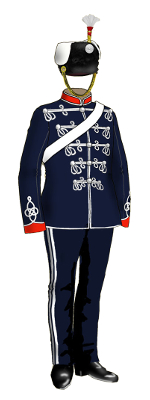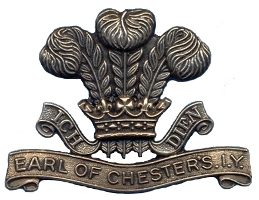|
Yeomanry Cavalry |
|
|
| 1803: |
The Cheshire Yeomanry Cavalry
│ |
| 1803: |
The Earl of Chester’s Regiment of
Cheshire Yeomanry Cavalry
│ |
| 1806: |
The Earl of Chester’s Legion
│ |
| 1814: |
Prince Regent’s Corps of
Cheshire Yeomanry Cavalry
│ |
| 1819: |
Prince Regent’s 1st Regiment of
Cheshire Yeomanry Cavalry
│ |
Prince Regent’s 2nd Regiment of
Cheshire Yeomanry Cavalry
│ |
|
 |
 |
| 1820: |
Prince Regent’s Cheshire Volunteer Legion
│ |
| 1821: |
The King’s Cheshire Volunteer Legion
│ |
| 1824: |
The King’s Cheshire Legion of Yeomanry Cavalry
│ |
| 1825: |
The King’s Cheshire Regiment of Yeomanry Cavalry
│ |
| 1837: |
The King’s Own Regiment of Cheshire Yeomanry Cavalry
│ |
| 1838: |
The King’s Regiment of Cheshire Yeomanry Cavalry
│ |
| 1849: |
The Earl of Chester’s Regiment of Cheshire Yeomanry Cavalry
│ |
|

│ |
| 1901: |
sponsored
21st (Cheshire) Company,
22nd (Cheshire) Company,
2nd Battalion,
Imperial Yeomanry |
│ |
|
Renaming to Imperial Yeomanry |
|
│ |
| 1901: |
The Cheshire Imperial Yeomanry
(Earl of Chester’s) |
|

│ |
|
Creation of the Territorial Force |
|
│ |
| 1908: |
The Cheshire Yeomanry
(Earl of Chester’s) (TF) |
|

│ |
1914/
1918: |
1/1st, 2/1st and 3/1st
Cheshire Yeomanry
(Earl of Chester’s)
│ |
|
Creation of the Territorial Army |
|
│ |
| 1921: |
The Cheshire Yeomanry
(Earl of Chester’s) (TA)
│ |
| 1941: |
transferred to
The Royal Armoured Corps |
│ |
| 1942: |
17th Lines of Communication Signals,
Royal Corps of Signals
│
|
| 1945: |
5th Lines of Communication Signals,
Royal Corps of Signals
│
|
|
Resurrection of the Territorial Army |
|
│ |
| 1947: |
The Cheshire Yeomanry
(Earl of Chester’s) (TA)
transferred to
The Royal Armoured Corps |
│ |
|
Creation of the Territorial and Army Volunteer Reserve |
|
│ |
| 1967: |
disbanded and formed parts of
The Cheshire Yeomanry
(Earl of Chester’s)
(Territorials) |
|
|




